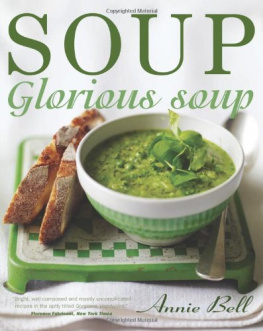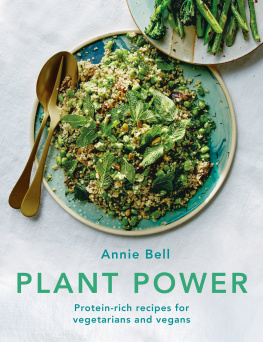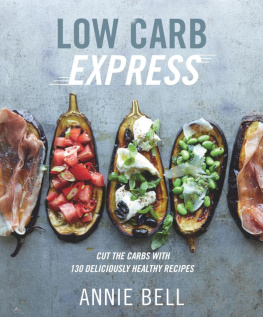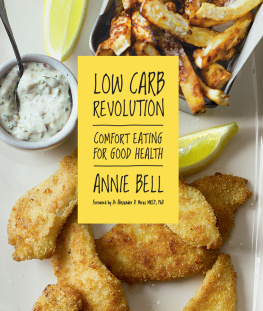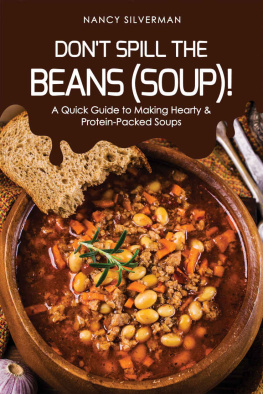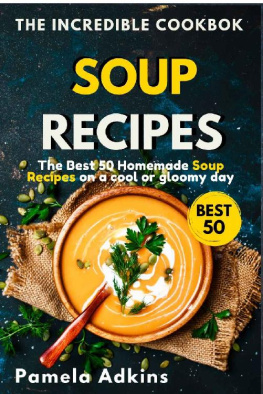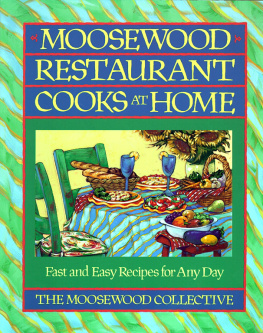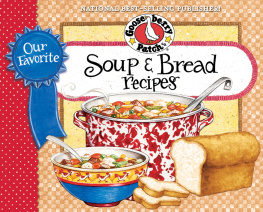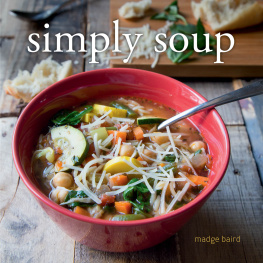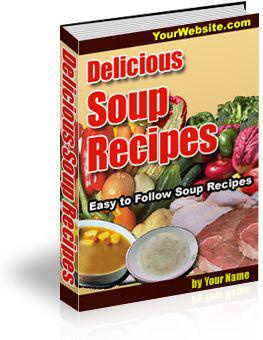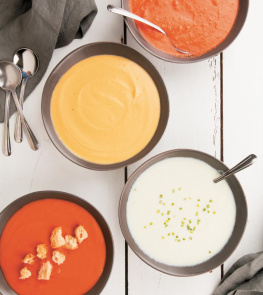Annie Bell - Soup glorious soup
Here you can read online Annie Bell - Soup glorious soup full text of the book (entire story) in english for free. Download pdf and epub, get meaning, cover and reviews about this ebook. year: 2020, genre: Home and family. Description of the work, (preface) as well as reviews are available. Best literature library LitArk.com created for fans of good reading and offers a wide selection of genres:
Romance novel
Science fiction
Adventure
Detective
Science
History
Home and family
Prose
Art
Politics
Computer
Non-fiction
Religion
Business
Children
Humor
Choose a favorite category and find really read worthwhile books. Enjoy immersion in the world of imagination, feel the emotions of the characters or learn something new for yourself, make an fascinating discovery.
- Book:Soup glorious soup
- Author:
- Genre:
- Year:2020
- Rating:5 / 5
- Favourites:Add to favourites
- Your mark:
- 100
- 1
- 2
- 3
- 4
- 5
Soup glorious soup: summary, description and annotation
We offer to read an annotation, description, summary or preface (depends on what the author of the book "Soup glorious soup" wrote himself). If you haven't found the necessary information about the book — write in the comments, we will try to find it.
Soup glorious soup — read online for free the complete book (whole text) full work
Below is the text of the book, divided by pages. System saving the place of the last page read, allows you to conveniently read the book "Soup glorious soup" online for free, without having to search again every time where you left off. Put a bookmark, and you can go to the page where you finished reading at any time.
Font size:
Interval:
Bookmark:




Select one of the chapters from the and you will be taken straight to that chapter.
Alternatively, jump to the to browse recipes by ingredient.
Look out for linked text (which is blue) throughout the ebook that you can select to help you navigate between related sections.
You can double tap images to increase their size. To return to the original view, just tap the cross in the top left-hand corner of the screen.
A recent American university study came to the conclusion that we can all be defined as particular character types depending on our soup preference. Aside from marvelling that any educational establishment can find the resources to carry out this kind of research, it left me feeling I must be suffering from a personality disorder. I for one cannot choose. Asked to name a favourite between a smooth silky onion soup, gazpacho, a mealy lentil soup, a thin hot and sour Thai broth, a luxurious garlic-rich bourride, a chicken noodle soup and a smoked haddock chowder, I would be left tongue-tied and dithering. Thankfully I dont have to.
Soup encompasses every possible conception of liquid, and increasingly not-so-liquid sustenance, catering to every whimsical mood and occasion. But most importantly, it is so often a way of making the best of whatever ingredients we have to hand.
This is not to say it is a vehicle for using up odds and ends, although on occasions you can achieve very fine results by marrying whatever you have in the fridge. Countless soups in this book have been born of an enjoyable early evening hour spent hovering over the stove, adding, tasting, simmering, adding and tasting. But never should this involve bits of this and bits of that which are past their best; fill a pot with second-rate ingredients and you will get a second-rate soup. The one exception to the rule is a vegetable that has a good flavour but a poor texture, that will make an excellent creamed soup once it has been pured and sieved. But if the flavour isnt there in the first place, you wont turn water into wine.
Any economy of means lies with the soup cycle as it were, the way it fits into our weekly repertoire. For any household who settles to roast chicken or guinea fowl on a regular basis, it is good husbandry to take it to its logical conclusion and simmer up a pot of stock at the end. Slightly stale bread can also be turned into a virtue, something not lost on French patisseries where the faintly burned or day-old loaves are sold in a basket labelled as pain au soupe, for crumbling into a pot au feu or a poule au pot to eke it out. But aside from such parsimony, a beautiful soup begins with beautiful ingredients.
This doesnt necessarily mean expensive. Soups based on lentils and beans, and pot vegetables such as carrots, celery and onions, have humble roots. But others such as fish soups, and ones containing lots of cheese or a large amount of herbs will be among the most luxurious dishes you can devise. Either way, the starting point is to go shopping.
I am showing my age when I reminisce that shopping for food as a child meant a stroll down a parade of shops, a trip in turn to the greengrocer, the butcher, the fishmonger, the baker and that near extinct shop, the grocer, with its shelves stacked with artfully packaged dried beans, lentils and rice, spices and flour. Even though such shopping today is the stuff of week-end jaunts and holidays when there is the time to indulge, I still map out what I am going to buy in this way.
Aside from the quality of the produce, the experience itself is so pleasurable. Being able to look at ingredients, to admire the way they are displayed and packaged, seeking advice from those selling them or inspiration on how to cook them, generally engaging with someone with the produce at the centre, is a precursor to cooking it.
Hence the chapters that follow evoke a stroll down a traditional high street, each shop doing what it does best. Most soups will contain a selection of ingredients, but for every one there is normally a single ingredient at its heart that relates to one particular shop be it leeks from the greengrocer for a potage parmentier, some mussels from the fishmonger for a moules marinire or a hunk of mature farmhouse Cheddar for a cauliflower cheese soup. And I believe if you approach soups in this way, centring them on one fine ingredient and letting that lead, rather than as a way of using up unwanted odds and ends, then you will create something special.
There is always an element of fashion within cooking, and soups mirror this more than many other foods. Aside from approaching them from a different angle to our forebears for whom they were most often a means of parsimony, there has been a broadening out in our perception of soup in recent years.
Traditionally soups were either thin, creamed or consomms, whereas today they embrace all manner of dishes that are halfway to being stews. I adore these kind of soups, a mass of vegetables and snippets of meat, often with lots of extra virgin olive oil and chopped herbs.
The dividing line between is it or isnt it a soup?, is for me whether or not you would ladle it over buttery spuds or rice. If, despite its heartiness, you would eat it with a spoon and some bread on the side, then in my eyes it qualifies as a soup. So many of the recipes in this book, and in particular in the butcher and fishmonger chapters, are the stuff of main courses. There are also classic creamed or pured soups, and others that broaden out the perception a jellied red pepper and tequila soup for instance, which can be eaten scooped onto fine slivers of toast, or a French onion soup baked in the oven, that is something like a savoury bread pudding.
I am more inclined to afford soup the star role with some cheese to follow than to make it the first course. And it fits so well into family life my love of soups was kindled with the advent of young children who are inveterate dippers. They love nothing more than dunking a piece of bread into soup, a great way of deceiving them into eating all manner of nutritious vegetables they might otherwise turn their noses up at. Its an excuse for a trip to the baker for a well-crafted rustic loaf that succeeds in being moist and chewy at the same time, with a crust that invites your teeth to grip and tear it apart. In a perfect world it will have been baked in a wood-fired oven, its base cast with a pale greeny-grey bloom of ashes, which all adds to the flavour. Treat yourself to a particularly fine loaf or two, with rosemary, olives or garlic, sunflower seeds and spelt, or walnuts, or a loaf that includes potato or maize, or a sourdough bread, all of which add to the general joie de vivre of a large warming bowlful.
I also love dressing soups up, whether its a fried crouton swiped with a clove of garlic in the bottom of the bowl to soak it up, or a spoon of crme frache mashed with Roquefort cheese that melts into it. So there are lots of suggestions for little asides and frills in what follows, but few are essential and if all you are after is a really simple bowlful, then these can be left out. But otherwise, hidden treasures and surprises add to the interest, and that most comforting of meals, a soup supper.
Font size:
Interval:
Bookmark:
Similar books «Soup glorious soup»
Look at similar books to Soup glorious soup. We have selected literature similar in name and meaning in the hope of providing readers with more options to find new, interesting, not yet read works.
Discussion, reviews of the book Soup glorious soup and just readers' own opinions. Leave your comments, write what you think about the work, its meaning or the main characters. Specify what exactly you liked and what you didn't like, and why you think so.

